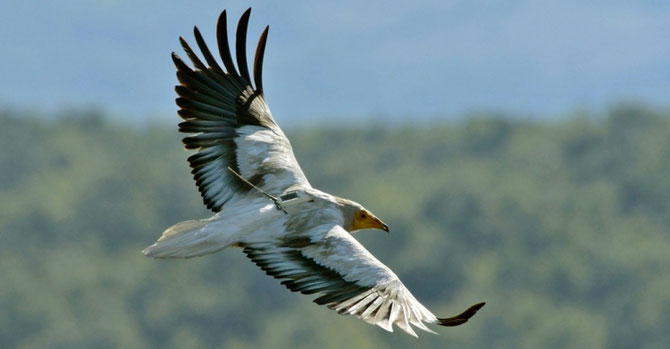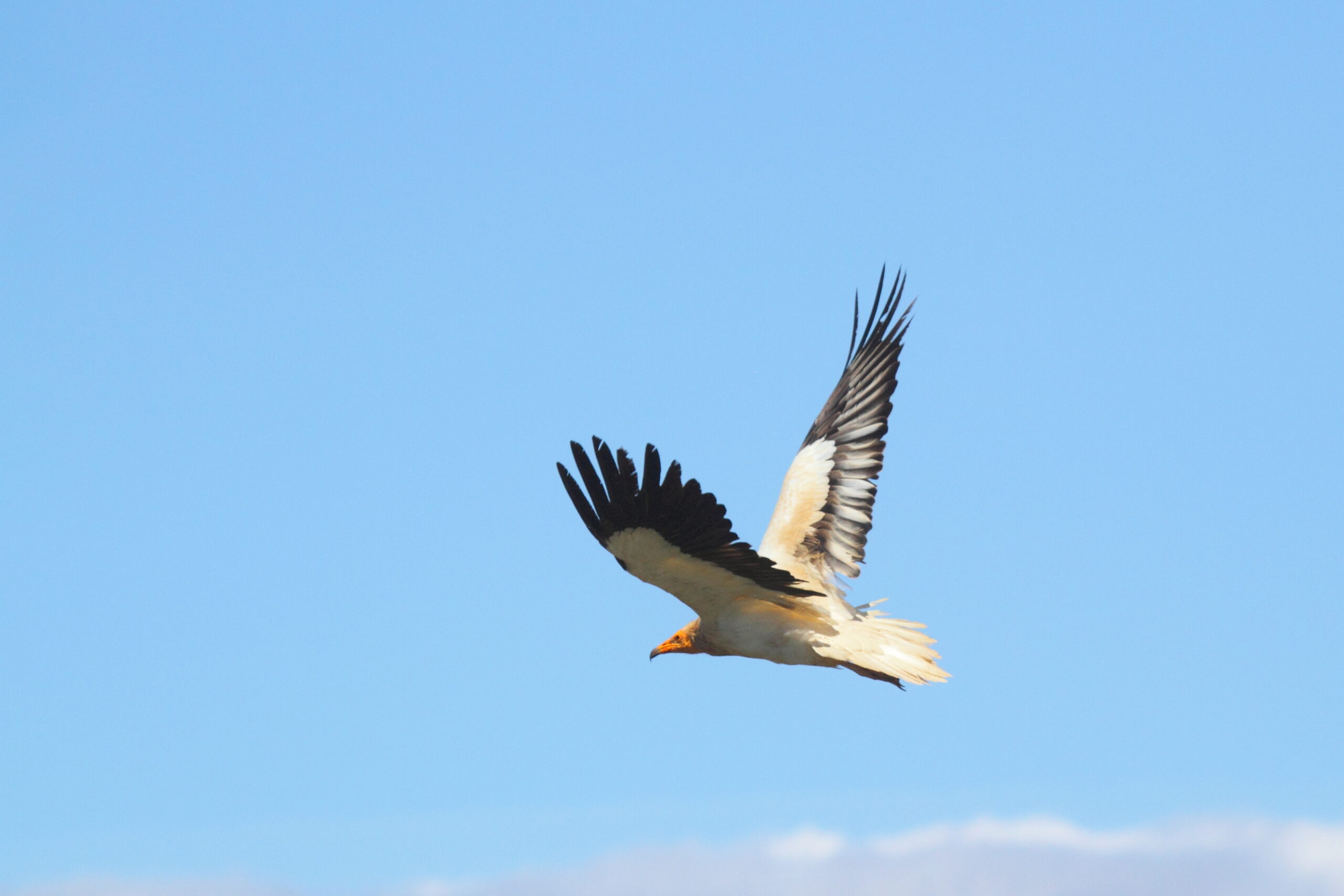
Adapted from a blog article written by Dr Steffen Oppel, RSPB
What happens if a goat dies in the hills of Albania, or Lebanon, or the deserts of Ethiopia? Most likely, you won’t care one bit. But the carcass festers under the sun for a day or two, and then nature’s clean-up crew arrives: vultures. And for one species a single bird could actually clean up carcasses in all of these locations within a few weeks: Egyptian Vultures are the only long-distance migrants among Eurasian vultures.
How can we save Egyptian Vultures?
Egyptian Vultures are not only the marathon fliers, but they are also the most threatened of any of the European vultures, and there are many regional conservation projects to save them. But to save migratory species, you first need to understand where the birds migrate to. For example, Egyptian vultures have declined dramatically on the Balkan peninsula and in Italy – but do the birds breeding in those areas migrate to the same wintering areas? Will the bird that eats dead goats in Albania in July look for food in Ethiopia in December, or rather in South Sudan, Chad or Niger?

For the past ten years, researchers and conservationists have equipped Egyptian Vultures with tracking devices to document their migration. Now, in a new collaboration published this week in the journal Frontiers in Ecology and Evolution, scientists from across Europe and the Middle East have combined their data to compare Egyptian Vulture migrations: who has the longest migration, the most convoluted route, and whether the birds that breed together in one country also winter together in Africa.
The different migration journeys of Egyptian Vultures
The birds breeding in Spain and France had the shortest migration. They crossed the Straight of Gibraltar and then flew south to winter in Senegal, Mauritania or Mali – a journey of roughly 3000 km generally completed within 2-3 weeks. The birds breeding on the Balkan peninsula travelled roughly 2000 km more during every migratory journey, because they first flew around the Mediterranean Sea, and then around the Red Sea – detours that took on average 1-3 weeks longer.
Egyptian Vulture Migration from Vulture Conservation Foundation on Vimeo.
Animation by Dr Evan Buechley
The detour around major water bodies is a typical phenomenon for many large migratory birds. Egyptian Vultures use columns of warm, rising air to get a free lift hundreds of meters up into the air, and then gradually glide for a few kilometers until they find the next free lift. From one lift to the next, they work their way to Africa at a rate of about 200 km per day. This strategy works very well over land, but fails miserably over the sea because there are no free lifts available. Most Egyptian Vultures that tried to take a shortcut across the Mediterranean Sea, therefore, paid with their lives and drowned. Compared to the almost certain death in the sea, a 2000 km detour through the Middle East does not look so bad.
Besides the amazing journeys of up to 10,983 km, the study also found that by and large the birds breeding on one part of Europe winter in the same part of Africa. Birds from western Europe wintered in western Africa, and birds from eastern Europe in eastern Africa or the Arabian peninsula. However, within these sub-populations, there was an enormous variability of where birds migrated to. Birds breeding in the Balkans, for example, travelled through 28 different countries and wintered from Niger in the east to Yemen in the west – an expanse of over 4000 km of desert.
This broad distribution presents real challenges for the conservation of the species, says Steffen Oppel, a conservation scientist at the RSPB who contributed to the study. “The threats to vultures vary by country – in the Middle East they get shot, in Ethiopia they get electrocuted, in Greece they get poisoned, and in Nigeria they are sold on markets. The more countries they visit the more solutions we need to develop to reduce all these threats.”
This kind of research can provide the foundations for finding effective solutions, says Louis Phipps, VCF’s research officer who co-led this collaborative effort. “Mapping out the migration routes of the different breeding populations across Europe is an essential first step in understanding the threats that they face throughout their annual cycle. This was only possible because many conservation organizations and research groups were willing to share data, providing a great example of how cross-continental collaboration can reveal interesting insights into vulture behavior that can be used to inform conservation action.” Tracking data from the LIFE Rupis project were included in the analysis, providing a first description of the migration patterns of Egyptian Vultures from the Douro Valley.
Together with BirdLife International, the RSPB aims to reduce threats along the flyway– and you can add your voice to speak out against the illegal killing of migratory birds.

This new study has not only revealed the variability in migration of Egyptian Vultures, and their exposure to threats in over 40 countries along their migratory routes, but also highlighted new avenues for research. Are populations most threatened where migratory journeys are the longest and most convoluted? How may climate change affect the bird’s ability to perform their migrations in the future?
In early October, the scientists will meet for the first European Vulture Conference to discuss future collaborations that may save the only species that travels thousands of kilometers to clean up dead goats.

Louis Phipps (VCF’s Research Officer), Steffen Oppel, Pascual Lopez-Lopez and Evan Buechley are co-lead authors of this paper.



